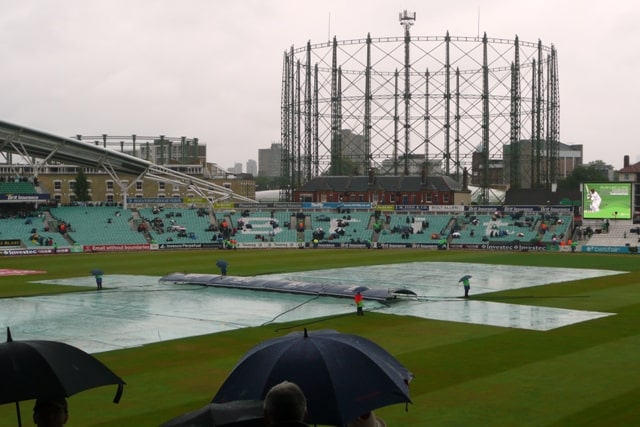DL Method Calculator
DL Method Calculator | Cricket Target Score Calculation. Rain Affected games.
Add your scores to the calculator and tabulate the target scores based on Duckworth Lewis Target method.

How to use this DL Method Calculator Tool?
The DLS method stands for the Duckworth-Lewis-Stern method. It is a mathematical formulation used in cricket to calculate target scores for the team batting second in limited-overs cricket matches affected by weather interruptions or other disruptions.
The DLS method takes into account various factors such as the number of overs remaining, wickets lost, and the resources available to the batting team to chase a revised target. It aims to provide a fair and equitable target for the team batting second based on the likely resources available to them if the match had proceeded without interruption.
The DLS method was introduced to replace the earlier Duckworth-Lewis method, with adjustments made to address certain perceived shortcomings and ensure greater accuracy in determining revised target scores in interrupted matches.
Overall, the DLS method is an important tool used in cricket to ensure fairness and maintain the integrity of limited-overs matches affected by weather or other factors beyond the control of the players.
Online DL Method Calculator Example
Below is an example of the original DL Method Calculator and the result.
Original DL Method Calculator ExampleTeam A Runs : 200 Team A Wickets : 5 Maximum Overs : 50 Team B Overs : 20 Team B Wickets : 3
And an example of how the online DL Method Calculator works.
DL Method Calculator ResultThe Target for Team B is 77
A very useful Duckworth Lewis Target Calculator for cricket lovers. The below DL calculator(Duckworth Lewis Target Calculator) for cricket is used to calculate the winner team as well as show result of a rain interrupted match. The Duckworth Lewis Method DL calculator is a mathematical way to best calculate the match result as well as points of Team A(India) and Team B(Pakistan) in a one-day or Twenty20 cricket match, when the match has been interrupted any way by weather or other such natural circumstances.
This DL calculator will help you to decide which cricket team is won the match during rain and any other natural calamities.The DL Method is also called as The Duckworth Lewis Method.
How to Duckworth Lewis method works – What is DLS?
let's assume the T-20 match between india(Team X) and pakistan(Team Y) so now calculate the dl Method
Pakistan(Team Y) Par Score = India(Team X) Score x Pakistan( Team Y) Resources / India(Team X) Resources )
It was 20-over match and Team X completed its innings uninterrupted, then they had 100% resource available to them, so the formula simplifies is
Team Y par score = Team X score x (Team Y resources/Team X resources).
Given the total number of overs available and wickets lost, we utilise a lookup table for the Standard Edition of the Duckworth Lewis method to find the overall percentage of resources.
How is DLS method Calculated?
When a team batting second in limited-overs cricket finds itself in an impossible situation, the Duckworth-Lewis-Stern (DLS) method can be used to help predict which side will win.It is an equation used to determine the goal score for the team pursuing when a game is stopped due to inclement weather or other reasons.
What is the Duckworth Lewis method of calculator?
When the match gets delayed by rain, the Duckworth-Lewis-Stern approach, also called as the DLS method, is a computational process used to determine the target scores.It is invented by English Mathematicians Frank Duckworth and Tony Lewis which bears their names.In 1997 seen the first use of the DLS technique. Australian educator Steve Stern changed the algorithm later in 2015, ahead of the ICC World Cup, and his name was subsequently added to the title.
What is the Duckworth Lewis method?
A mathematical technique called the Duckworth-Lewis-Stern is used to determine target scores and results in limited-overs contests that are shortened by rain. It was created and named after English statisticians Frank Duckworth and Tony Lewis, and it was utilised for the first time in 1997. In 2015 Austr,alian academic steve Stren updated the formula and his name added to the title.
How to use Yttags's DL Method Calculator?
- Step 1: Select the Tool

- Step 2: Enter The Following Steps And Click On The Calculate Button.

- Step 3: Check Your DL Method Calculator Result

One way to solve the problem is to cut the run target in direct proportion(dls method calculator for 50 overs) to the number of overs available. So if India first innings scores 310 runs from 50 overs and Pakistan second innings is given 30 overs, merely using the run rate per over would say that they only need 172 runs to win(The Target for Pakistan is 172).
DLS Full Form : Duckworth–Lewis–Stern method- D - Duckworth
- L – Lewis–Stern
- S – Method
Cricket, often hailed as a game of uncertainties, is known for its capriciousness when it comes to weather conditions. A key challenge in the sport is to ensure a fair result in matches affected by rain or other factors beyond players' control. Enter the Duckworth-Lewis-Stern (DLS) method, a formula-based system devised to determine target scores and results in limited-overs cricket matches affected by weather interruptions. This article will delve into the intricacies of the DLS method, its evolution, and its importance in modern cricket.
The Evolution of the DLS Method
The DLS method, originally known as the Duckworth-Lewis method, was conceived by statisticians Frank Duckworth and Tony Lewis in the early 1990s. The method was developed to address the challenges faced in limited-overs cricket, where a match can be interrupted by adverse weather conditions.
In 2014, the International Cricket Council (ICC) renamed the method as the Duckworth-Lewis-Stern (DLS) method, acknowledging the contributions of Steven Stern, who refined and improved the algorithm for better accuracy.
How Does the DLS Method Work?
The DLS method is based on a mathematical formula that uses several parameters to calculate target scores in rain-affected limited-overs matches. The key parameters include the number of overs available, the number of wickets lost, and the number of runs scored.
The method involves calculating a par score, which represents the average score that a team can expect to achieve under similar conditions. The par score is adjusted based on the number of overs lost and the number of wickets lost. The resulting target score is the adjusted par score plus any runs scored before the interruption.
The Importance of the DLS Method in Modern Cricket
The DLS method is an essential tool in modern cricket for several reasons:
-
Ensuring Fair Results: The DLS method ensures that matches affected by rain or other interruptions produce a fair result. It takes into account the impact of weather conditions on the game and adjusts the target score accordingly.
-
Providing a Framework for Decision-Making: The DLS method provides a clear framework for decision-making in rain-affected matches. It helps match officials and teams make informed decisions about the game's outcome and strategy.
-
Maintaining the Integrity of the Game: By providing a fair and transparent method for calculating target scores, the DLS method helps maintain the integrity of the game. It ensures that matches are decided based on merit rather than external factors.
-
Enhancing Spectator Experience: The DLS method enhances the spectator experience by ensuring that matches are not abandoned due to weather interruptions. It allows matches to continue and produce a result, even if the full quota of overs is not completed.
Conclusion
In conclusion, the DLS method is a crucial tool in modern cricket, providing a fair and transparent method for calculating target scores in rain-affected matches. It was developed to address the challenges faced in limited-overs cricket, where weather interruptions can have a significant impact on the game. The DLS method ensures that matches produce a fair result and maintains the integrity of the game.
the Duckworth-Lewis method provides a fair solution for interrupted cricket matches caused by rain. By considering the available resources (overs and wickets) of both teams, it calculates a target that reflects the difficulty level of the match despite the interruption. This method has replaced previous approaches like average run rate and most productive overs, which often resulted in unfair outcomes. Overall, the Duckworth-Lewis method ensures that matches affected by rain interruptions can be decided fairly and accurately.
List Of Cricket Calculators
- Batting Average Calculator
- Batting Strike Rate Calculator
- Bowling Average Calculator
- Bowling Strike Rate Calculator
- Cricket Score Counter
- DL Method Calculator
- Economy Rate Calculator
- Match Net Run Rate Calculator
- Required Run Rate Calculator
- Run Rate Calculator
- Tournament Net Run Rate Calculator
